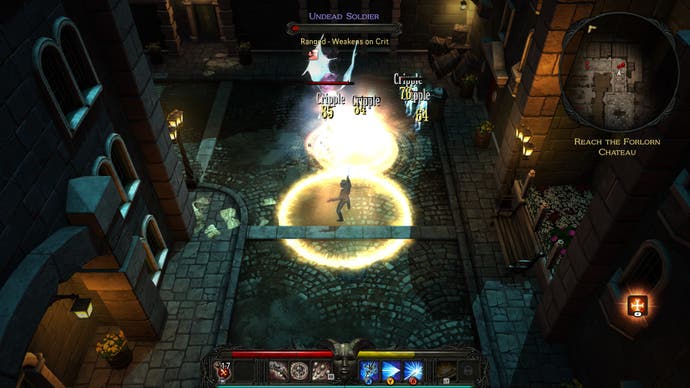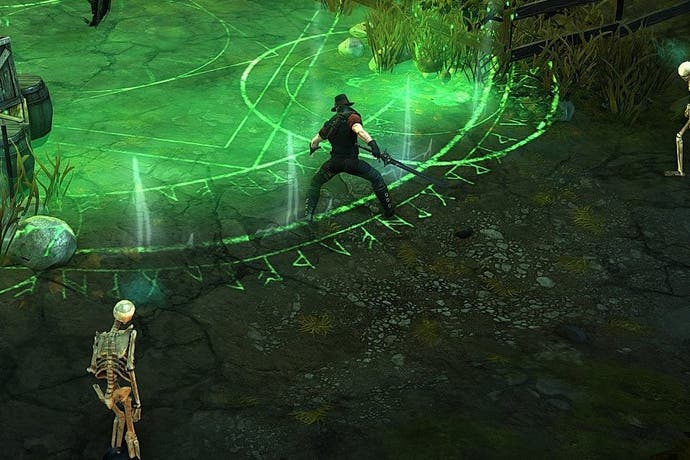Victor Vran review
Super scythe me.
"Doesn't it get a bit old, Victor, doing the same things over and over? Slaying monsters. Looting chests."
Humour is dangerous stuff for games, particularly this kind of humour - and particularly this kind of game. Victor Vran's a fairly classical ARPG, a problematic genre when things starts to become self-aware. ARPGs are all about hitting things in order to kill them and in the hope that they will cough up magical trousers while dying which, if worn, will allow you to hit things a bit harder and kill them a bit quicker. People who don't like ARPGs sometimes argue that they represent the video game void staring right back at you - endless escalation, empty acquisition - which is why it's always weirdly embarrassing when onlookers gather near you as you play Diablo or Titan Quest. The crowd never seems to get the appeal: it's just hitting stuff and collecting loot? Yes, it is just hitting stuff and collecting loot. But that can feel fabulous.
And it feels fabulous in Victor Vran, thankfully, so the game gets away with its jokes. At times it even earns them. While this is a very recognisable genre piece from the off, it has a range of interesting ideas at its core that makes it well worth checking out, even if you're hot off the back of Van Helsing 2 or other relatively similar games.
Take the process of building a character. There are no classes here, and no particle-shedding skills unlocked as you level. Instead, it's a bit like RPG Lego, and it all revolves around loot. Each weapon you equip - and you can equip two at a time - brings a trio of different attacks depending on its type, which means that you're swapping skills every time you trade your hammer for a shotgun. It makes sense, allowing a rapier, say, to be a far more focused option than a standard sword, which is much better suited to crowd control. Alongside delivering on the distinct feel of each weapon type, this also means that the loot game comes to the fore. It's a clear distinction from the early days of Diablo 3, for example, where the deadly maces and wands that spilled out of your foes felt like little more than stat boosts. Victor Vran grounds you in the moment, in the thwack and crunch of action as it unfolds.
It's not just weapon types. As you explore the mysterious, monster-choked citadel where the game is set - Victor Vran's a demon hunter with a dark secret, incidentally, and the game tasks you with finding out why everything around him has suddenly gone to Hell - you'll also collect Destiny cards that can be equipped to provide passive bonuses, gems, which give you super-powered Overdrive attacks, and outfits, which change the way in which you collect the Overdrive energy to power those attacks - whether you gather it by dealing damage, say, or build it up as time goes by.

Muddled together, this looty approach works really beautifully, and while it means that you don't get that frisson of excitement that comes from locking yourself into a choice that can't be undone, it also means that you get to mix and match as the occasion demands. And the occasion often demands. That rapier was my best friend for much of the early game, as I tackled a range of foes with slow attacks and relatively lengthy health bars, who tended to lunge at me in polite queues in the traditional manner of the low-level undead. As soon as I encountered exploding lava spiders, however - and I believe I am paraphrasing Austen here - I needed to rethink things, opting for a shotgun to keep attackers at range, and an Overdrive attack that sent out a staggered, seismic ripple, knocking enemies back and simultaneously clumping them together. Turns out one exploding lava spider sets off all the others. (Austen again.)
Switching between playing styles very quickly allows Victor Vran to feel wonderfully dynamic, even as the campaign settles into a bit of a rut with its enemy types - vampires, skeletons, lots and lots of spiders - and gently miscalibrates the flow of bosses, leaving you quite a while before facing your first, for example, before throwing you into a chain of four or five, one right after the other, a few hours later.

Adding to the fun is a thrifty alternative to side quests, which sees each new location you visit enlivened by a series of optional challenges - find the secret chests, kill ten of these, kill five of these really fast - that both encourages you to come back to old areas in idle moments when you tire of the main campaign, and also means that every new location comes with a five star completion meter sitting beneath its title on the map. It's nice to have something visual to work towards, of course, but much more importantly this gives players the false impression that places like The Devil's Throat and The Befouled Tomb have some arcane equivalent of a TripAdvisor score.
You can jump, too. This is a weird sort of addition for an ARPG, as are traversal moments where you access a new part of the map by wall-springing between two buildings, but it's also emblematic. This is bizarre to say, but Victor Vran plays much better with a control pad than it does with a mouse and keyboard. Clever button-mapping, coupled with that focus on individual weapons and the attacks they allow for, means that you have an ARPG that feels much more direct than many do. Even as you view the action from above, you are somehow right there in the middle of it too.
Beyond that, there's online co-op for teams of up to four - the browser's a bit basic, but I had fun nonetheless - and there's a wave-based endless area to unlock if you're after an end-game. Victor Vran's clearly been made on a fairly tight budget, then, but the design does a lot with a little, and its dark fantasy world is filled with character, from cobbled streets and autumnal slums, to playful Elites such as The King of the Pumpkins that Explode - a king whom, it must be said, lives up to his name quite beautifully - and probably makes for some memorable first days of parliament.
More than all that, the game's just extremely personable. The story is forgettable, but it's delivered via Victor's schlocky pronouncements and a playful, teasing, taunting voice in his head that seeks to unsettle you at every turn. ("Victor, you need a vigilante name. How about Hatman?") Equally, alongside the swamps and crypts you're expecting, you get standout locations like the Forlorn Chateau, a haunted mansion with a seriously unpleasant attic that delivers one of the most charismatic ARPG maps I've visited in quite a while. Sure, even middling ARPGs are almost always fun for an hour or so, but Victor Vran will keep you hitting stuff and collecting loot for a lot longer than you might expect.













